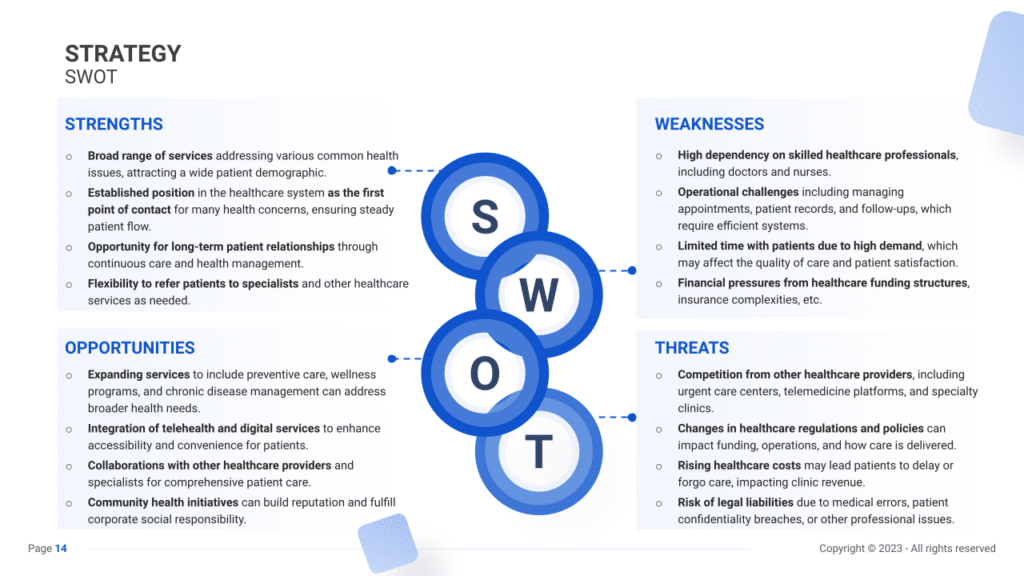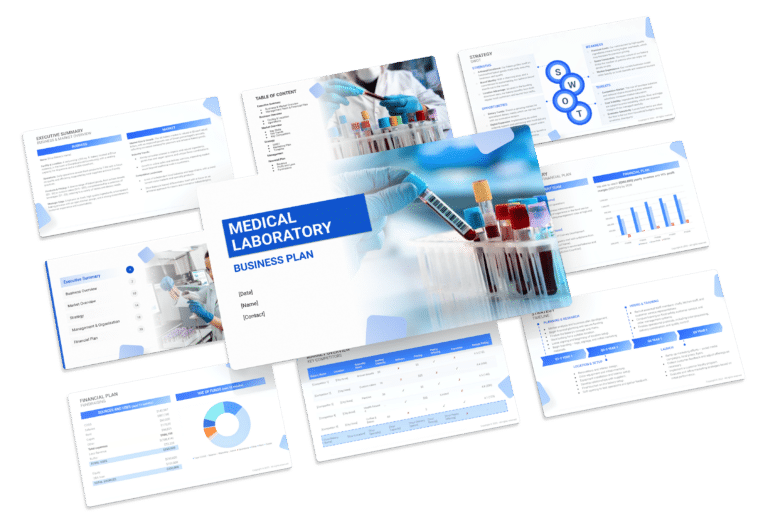How to Prepare a SWOT for a General Practice

In formulating a business plan for a general practice clinic, a SWOT analysis is indispensable. SWOT (Strengths, Weaknesses, Opportunities, Threats) serves as a framework, aiding clinic owners in assessing internal control factors and external impacts.
Strengths and weaknesses, within the clinic’s control, contrast with external opportunities and threats. A business plan with a SWOT analysis offers a comprehensive view of the clinic’s market standing, identifying avenues for growth.
Strengths may encompass a skilled medical team, advanced technology, and positive patient outcomes, while weaknesses might include limited services or outdated facilities. This article will explore diverse examples of strengths and weaknesses, providing clinic owners valuable insights for adeptly incorporating them into their business plans.

Strengths
- Experienced Medical Staff: General Practices often boast a team of seasoned professionals. Their expertise ensures high-quality patient care.
- Example: A practice with veteran physicians can leverage their reputation to attract new patients.
- Comprehensive Services: Offering a wide range of services can be a major strength. It makes one-stop healthcare possible.
- Example: Providing diagnostics and treatment under one roof enhances patient convenience.
- Community Trust: A well-established General Practice gains the community’s trust. This is invaluable for patient retention.
- Example: Practices with strong community ties often benefit from word-of-mouth referrals.
- Modern Facilities: State-of-the-art medical equipment and facilities can set a practice apart. They enable advanced care.
- Example: Investing in the latest technology can attract patients seeking cutting-edge treatments.
Weaknesses
- Operational Costs: High running costs can strain a General Practice’s finances. This affects sustainability
- Example: Reducing unnecessary expenses can improve the financial health of the practice.
- Staff Turnover: Frequent changes in staff can disrupt patient care continuity. It’s a significant weakness.
- Example: Offering competitive salaries and benefits may reduce staff turnover rates.
- Limited Marketing: Inadequate marketing efforts can hinder a practice’s visibility. It’s a missed opportunity.
- Example: Implementing a robust digital marketing strategy can increase patient inflow.
- Regulatory Compliance: Keeping up with healthcare regulations is challenging. Non-compliance can be costly.
- Example: Regular training sessions can keep the staff updated on compliance requirements.
Opportunities
- Telemedicine Expansion: Integrating telehealth services offers growth potential. It meets evolving patient needs.
- Example: Offering virtual consultations can tap into a wider patient base.
- Partnership Alliances: Collaborating with specialists can enhance service offerings. It’s a strategic move.
- Example: Partnerships with local specialists can provide patients with comprehensive care.
- Healthcare Technology: Leveraging new technologies can improve patient outcomes. It’s a significant opportunity.
- Example: Using AI for patient management can streamline operations and enhance care.
- Community Programs: Engaging in public health initiatives can boost the practice’s profile. It shows commitment.
- Example: Free health camps can raise awareness and showcase the practice’s services.
Threats
- Competitive Market: The growing number of healthcare providers increases competition. It’s a constant threat.
- Example: Differentiating services can help in staying ahead of competitors.
- Regulatory Changes: Healthcare policies are ever-changing. Adapting is essential for survival.
- Example: Staying informed about policy changes can prevent compliance issues.
- Economic Downturns: Economic instability can affect patients’ ability to pay. It impacts revenue.
- Example: Offering flexible payment plans can retain patients during tough times.
- Technological Disruptions: Failing to keep up with technological advances can render a practice obsolete.
- Example: Regularly updating medical software can keep the practice competitive.





